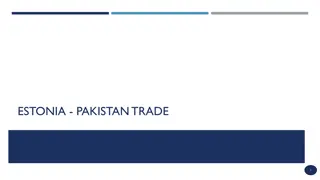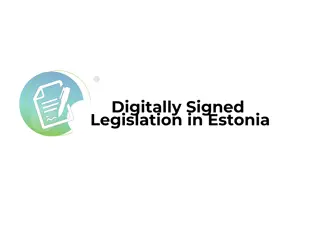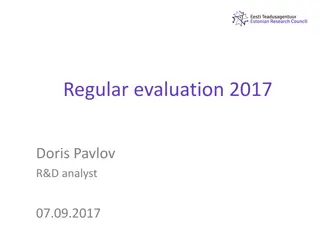Lessons from Mandatory Health Insurance Development and Governance in Estonia
Estonia has implemented a mandatory health insurance system through the Estonian Health Insurance Fund (EHIF) since 1992. The EHIF operates as a single-payer system, pooling public funds predominantly from a 13% payroll tax. Key aspects include high population coverage, independent governance, and financial stability despite challenges. The evolution of health insurance organization in Estonia reflects a strategic shift towards centralization and efficiency. Lessons from Estonia's experience can provide valuable insights for other countries exploring similar health financing models.
Download Presentation

Please find below an Image/Link to download the presentation.
The content on the website is provided AS IS for your information and personal use only. It may not be sold, licensed, or shared on other websites without obtaining consent from the author.If you encounter any issues during the download, it is possible that the publisher has removed the file from their server.
You are allowed to download the files provided on this website for personal or commercial use, subject to the condition that they are used lawfully. All files are the property of their respective owners.
The content on the website is provided AS IS for your information and personal use only. It may not be sold, licensed, or shared on other websites without obtaining consent from the author.
E N D
Presentation Transcript
Lessons from mandatory health insurance development and governance in Estonia Triin Habicht Subregional Dialogue on Health Financing in the Caribbean Barbados, 28- 29 August 2018
Estonia in brief Population 1.3 million High-income country European Union (since 2004) GNI per capita 17 750 USD* (2016) Health expenditures (2016) 6.7% of GDP Per person 1 340 USD Public expenditure 75.7% of THE Health insurance 65.0% of THE OOP 22.7% of THE Estonian Health Insurance Fund (EHIF) is a single payer Social health insurance system since 1992 *1USD=0.8EUR
Governance of Health Insurance
Public agencies in health sector Ministry of Social Affairs EHIF National Institute for Health Development Health Board State Agency of Medicines Contracts Health care providers, private law, public or private ownership
Evolution of the organization of health insurance First sickness funds in 1913 Re-established regional non-competing sickness funds in 1991/92 (22 in total) Central sickness fund to coordinate regional funds in 1994 Estonian Health Insurance Fund in 2001, Currently with 4 regional departments
Key facts about EHIF Estonian Health Insurance Fund (EHIF) is a single payer EHIF pools most of public funds The main source of revenues 13% payroll tax paid by employers Coverage with health insurance 94-96% of population EHIF operates as public independent legal entity Founded in public interest by separate act General public service regulation does not apply to EHIF Governed by Supervisory Board chaired by Minister of Health and Labor
EHIF revenues, expenditures and reserves 1200 000 Financial crisis 1000 000 800 000 in thousand Euros 600 000 Deficit 400 000 200 000 0 2004 2005 2006 2007 2008 2009 2010 2011 2012 2013 2014 2015 2016 Revenues Expenditures Reserves Source: EHIF
EHIFs reserves policy Solvency reserve: 5,4% of total budget since 2018 (8% in 2001- 2004, 6% 2005-2017) To balance macroeconomic risks Needs government approval Risk reserve: 2% of health insurance spending (introduced in 2002) To balance the risks of health insurance obligations Needs EHIF s supervisory board approval Accumulated surplus: non-mandatory reserve as difference between revenues and expenditures Accumulated before last financial crises Needs EHIF s supervisory board approval (<30% of total surplus, <7% of previous period s health care services budget)
Moving away solely contribution based health insurance Gradual increase of state budget contributions on the behalf of pensioners from 7% in 2018 up to 13% in 2022 On behalf on non-working pensioners Contribution is calculated as a share of average state guaranteed pension By 2022 new revenue source forms about 11% of the EHIF s budget In parallel, other public expenditure streams will be consolidated under the EHIF Aims to reduce fragmentation Was necessary to find a compromise in the Government As a result, the net growth of public spending is expected to be 0.2% of GDP by 2022
Tripartite supervisory board 15 members (will be reduced to 6 in Sept 18) 5 state representatives Minister of Health and Labor, Minister of Finance and Chairman of the Parliamentary Committee of Social Affairs (ex officio) 1 member or parliament (nominated by the Parliament) 1 public servant from Ministry of Social Affairs (nominated by the Government) 5 employer and 5 beneficiaries representatives Nominated by Government according to the proposal made by representing organizations Supervisory Board design is expected to prevent conflict of interest Supervisory Board decisions are public
Scope of decision rights of EHIF Establishment of system (objectives and principles) Parliament Contributions definition and coverage (eligibility) Parliament Co-payments general regulation by Parliament; actual co-payments by providers Benefit package general regulation by Parliament; actual benefit package by Government Provider payment methods and Prices Government; price calculation methodology by Ministry of Social Affairs Contracting basic principles by Parliament; specific principles by Supervisory Board of EHIF Waiting time limits Supervisory Board; for primary care by Ministry of Social Affairs Budget forecast by MoF; budget position by Parliament as part of State Budget; in detail by Supervisory Board
Accountability mechanisms Management Board shall present quarterly overview of the activities and economic situation to the Supervisory Board All reports made public Annual reports available in English https://www.haigekassa.ee/en/annual-reports 4-year corporate strategy with action plan and score card Reporting is part of the quarterly reporting Revised annually Available in English https://www.haigekassa.ee/sites/default/files/ uuringud_aruanded/hk_arengukava_a4_eng_ veeb.pdf Regular public and partners satisfaction surveys
Contracting and Payment Methods
Contracting cycle of EHIF Changes in health service prices and benefit package EHIF s 4-year budget planning principles and EHIF s 4-year development plan Annual (by 6 months) capped cost and volume contracts; 5- year framework contracts Quarterly contract, queue and budget monitoring and utilization review Negotiations about contract volumes EHIF s annual budget Selection of partners Pooling in EHIF Adjustments of contract if necessary Demand/need assessment by specialities (running and next year perspective) Framework contract conditions negotiated and agreed among EHIF and Estonian Hospital Union or Estonian Society of Family Physicians
Providers network Legal entities acting under private law Licensed by Health Board Hospitals mostly owned by central government, municipalities, other entities under public law (university) or private investors 20 strategic hospitals ( Hospital Master Plan providers) PHC providers mostly private
Market shares in specialist care (in 2016) Selected partners 7% General hospitals 12% Regional hospitals 52% Central hospitals 29%
Financial planning of specialist care contracts Factors that are taken into account: Equal access by regions Waiting times Capacity of the provider Historical utilization Expected changes in service delivery (e.g. more day surgery) Patient preferences Changes in tariffs, benefit package Care concentration for complex care Cost and volume are determined for each provider Cost and volumes by specialties and by care types as outpatient, daycare, inpatient Services provided over the contract volume are covered on certain conditions by 70% for outpatient and day care (up to 5% of total contract volume) and 30% for inpatient care
Provider payment methods in transition Revision of P4P to incentivize more adherence to the guidelines Piloting integrated care model (hospital+PHC center) Primary care: capitation, FFS, monthly allowance, P4P Outpatient specialist care: FFS New PHC Centers payment model Pay for high-rist patient management Inpatient specialist care: DRG, per diem, FFS, preparedness fee Global budget (pilot in rural hospital) Episode based payment
Also, service delivery model is changing Primary care: family doctor+nurse, mostly solo practices Primary care: group practices, extended team (home nurse, midwife, physiotherapist) Hospitals: independent entities Hospital networks Primary and specialist care split
Evolution of digital claims Digital claims system was started to develop in mid-90s By end of 90s regional insurance funds had digital database In 2000, one country-wide database including all claims and providers were incentivized to submit digital data Since 2003, focus on data quality and how to use claims data to support strategic purchasing
Digital claim Claims standard format set in the EHIF s contract: defines data fields, types, number of characters by field, etc Data fields: person s characteristics and ID provider information primary and secondary diagnoses (ICD10) clinical activities based based on health service price list and Nordic Classification of Surgical Procedures price and volume information
Key messages Single-payer model has been proven to work well in Estonia Strong institutional framework with governance structure Broader revenue base will increase financial sustainability Financial incentives across different levels of care are important to achieve UHC Blending payment methods enables to mitigate negative side-effects of single payment method Strategic purchasing in much more than payment methods Health financing reforms have to be aligned with broader health service delivery reforms Good quality data is a precondition for monitoring the performance of providers























